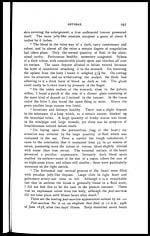Medicine - Veterinary > Veterinary diseases > Elephants and their diseases > Part V - Infective diseases
(360) Page 296
Download files
Individual page:
Thumbnail gallery: Grid view | List view

296 A TREATISE ON ELEPHANTS.
and on no account be made use of in any surgical case, as for
instance, opening an abscess. Care must be taken not to scatter
organs or blood about the place, but to restrict the area infected
to the smallest limits. A very deep pit should be prepared alongside
and the carcase tumbled in. The soiled area should be well sprinkled
with carbolic powder or other strong disinfectant, the ground dug up
and thrown into the pit, a thick layer of straw should then be spread
all over the ground and fired. The area should be strongly fenced in.
The belly is usually greatly inflated, bloody discharge may be
noticed from the natural openings, decomposition sets in rapidly,
swellings may be present beneath the skin.
The blood is of a dark, tarry and fluid character, often staining
the cavities of the heart and interior of the blood vessels a peculiar
red tinge. Any of the organs or all, namely, liver, spleen, kidneys,
lungs, brain, may be found engorged with blood, and their substance
softened, and the spleen especially is usually found enormously
enlarged. In one case it weighed 62½ lbs. The cavities, that is,
the abdomen, chest, heart-bag, and cranial, may contain blood-stained
fluid, and the lining membranes have scattered over them purplish
blood spots or blotches. The bowels may be thickened, their
contents bloody, and the lining membrane scattered over with
purplish blood spots or patches.
The tumours above referred to consist of a yellowish greengage
jelly-like material, which may have a dark centre and may be found
in other parts, notably in the mesentery, or membrane connecting
the bowels to the spine, around the kidneys, furrows of the heart,
about the throat and other places, and when present may be taken
as very indicative of anthrax.
The following cases are recorded by Frost :—
" Post-mortem on an elephant belonging to the Commissariat
Department, Rangoon. Died at 4-30 P.M. on the 25th of June
1878, after an illness of two days.
" Body well nourished and muscles of healthy hue. On
removing the right fore-limb, my attention was at once drawn to
the peculiar jelly-like deposit found in cases of anthrax. This
deposit existed to a considerable extent in the connective tissue of
the chest, muscles, and between the shoulder-blade and the ribs.
In parts the deposit was of a yellowish white, and in others of a rosy
hue.
" Before commencing my examination of the body, and when
conversing with Colonel Hawkes, Executive Commissariat Officer,
1 was told that amongst other symptoms exhibited by the animal
was a small tumour in the region of the left parotid gland. I had
the body turned in order to examine the tumour. On removing the
Set display mode to: Large image | Zoom image | Transcription
Images and transcriptions on this page, including medium image downloads, may be used under the Creative Commons Attribution 4.0 International Licence unless otherwise stated. ![]()
| India Papers > Medicine - Veterinary > Veterinary diseases > Elephants and their diseases > Infective diseases > (360) Page 296 |
|---|
| Permanent URL | https://digital.nls.uk/75193158 |
|---|




